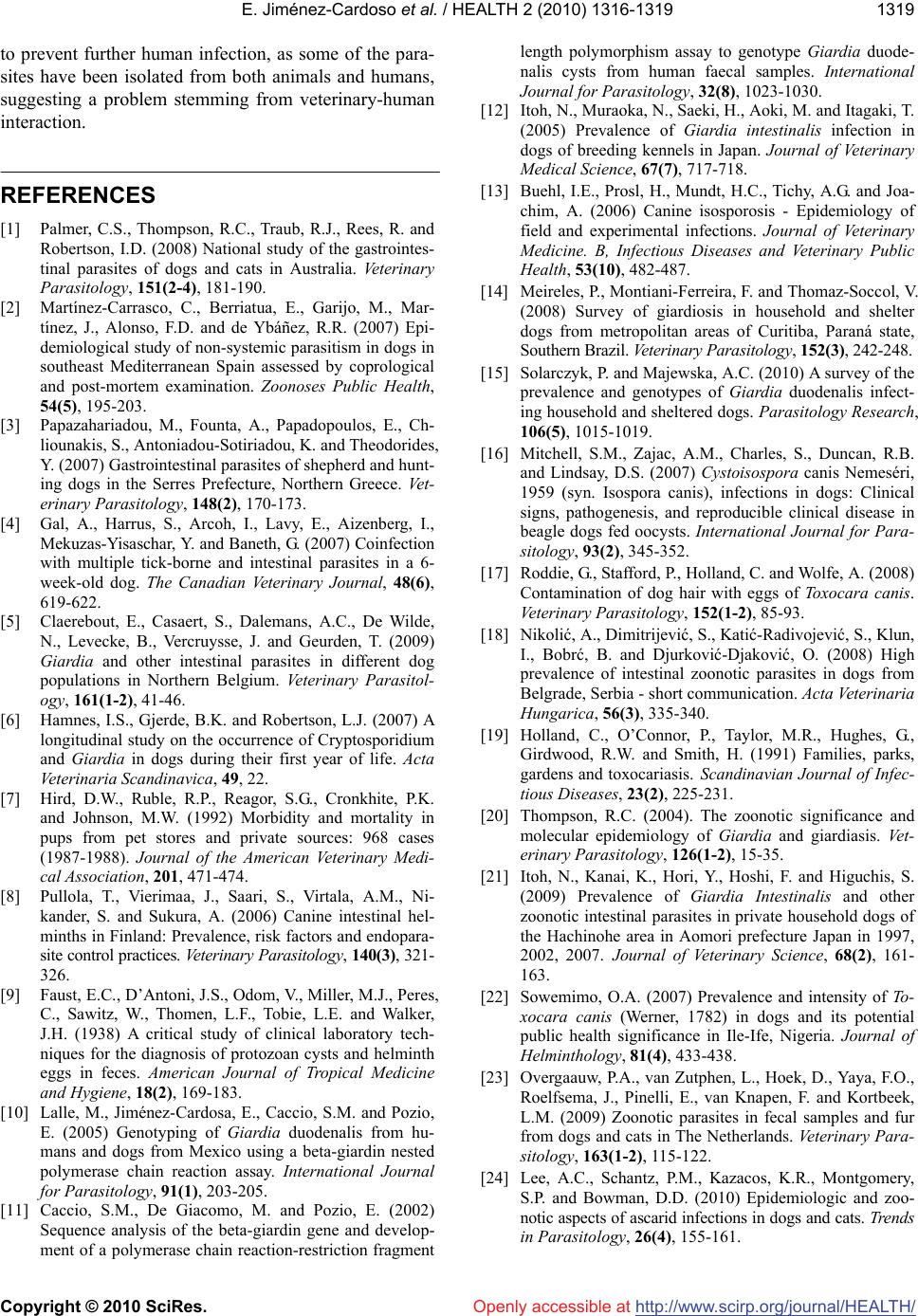
E. Jiménez-Cardoso et al. / HEALTH 2 (2010) 1316-1319
Copyright © 2010 SciRes. http://www.scirp.org/journal/HEALTH/
1319
Openly accessible at
to prevent further human infection, as some of the para-
sites have been isolated from both animals and humans,
suggesting a problem stemming from veterinary-human
interaction.
REFERENCES
[1] Palmer, C.S., Thompson, R.C., Traub, R.J., Rees, R. and
Robertson, I.D. (2008) National study of the gastrointes-
tinal parasites of dogs and cats in Australia. Veterinary
Parasitology, 151(2-4), 181-190.
[2] Martínez-Carrasco, C., Berriatua, E., Garijo, M., Mar-
tínez, J., Alonso, F.D. and de Ybáñez, R.R. (2007) Epi-
demiological study of non-systemic parasitism in dogs in
southeast Mediterranean Spain assessed by coprological
and post-mortem examination. Zoonoses Public Health,
54(5), 195-203.
[3] Papazahariadou, M., Founta, A., Papadopoulos, E., Ch-
liounakis, S., Antoniadou-Sotiriadou, K. and Theodorides,
Y. (2007) Gastrointestinal parasites of shepherd and hunt-
ing dogs in the Serres Prefecture, Northern Greece. Vet-
erinary Parasitology, 148(2), 170-173.
[4] Gal, A., Harrus, S., Arcoh, I., Lavy, E., Aizenberg, I.,
Mekuzas-Yisaschar, Y. and Baneth, G. (2007) Coinfection
with multiple tick-borne and intestinal parasites in a 6-
week-old dog. The Canadian Veterinary Journal, 48(6),
619-622.
[5] Claerebout, E., Casaert, S., Dalemans, A.C., De Wilde,
N., Levecke, B., Vercruysse, J. and Geurden, T. (2009)
Giardia and other intestinal parasites in different dog
populations in Northern Belgium. Veterinary Parasitol-
ogy, 161(1-2), 41-46.
[6] Hamnes, I.S., Gjerde, B.K. and Robertson, L.J. (2007) A
longitudinal study on the occurrence of Cryptosporidium
and Giardia in dogs during their first year of life. Acta
Veterinaria Scandinavica, 49, 22.
[7] Hird, D.W., Ruble, R.P., Reagor, S.G., Cronkhite, P.K.
and Johnson, M.W. (1992) Morbidity and mortality in
pups from pet stores and private sources: 968 cases
(1987-1988). Journal of the American Veterinary Medi-
cal Association, 201, 471-474.
[8] Pullola, T., Vierimaa, J., Saari, S., Virtala, A.M., Ni-
kander, S. and Sukura, A. (2006) Canine intestinal hel-
minths in Finland: Prevalence, risk factors and endopara-
site control practices. Veterinary Parasitology, 140(3), 321-
326.
[9] Faust, E.C., D’Antoni, J.S., Odom, V., Miller, M.J., Peres,
C., Sawitz, W., Thomen, L.F., Tobie, L.E. and Walker,
J.H. (1938) A critical study of clinical laboratory tech-
niques for the diagnosis of protozoan cysts and helminth
eggs in feces. American Journal of Tropical Medicine
and Hygiene, 18(2), 169-183.
[10] Lalle, M., Jiménez-Cardosa, E., Caccio, S.M. and Pozio,
E. (2005) Genotyping of Giardia duodenalis from hu-
mans and dogs from Mexico using a beta-giardin nested
polymerase chain reaction assay. International Journal
for Parasitology, 91(1), 203-205.
[11] Caccio, S.M., De Giacomo, M. and Pozio, E. (2002)
Sequence analysis of the beta-giardin gene and develop-
ment of a polymerase chain reaction-restriction fragment
length polymorphism assay to genotype Giardia duode-
nalis cysts from human faecal samples. International
Journal for Parasitology, 32(8), 1023-1030.
[12] Itoh, N., Muraoka, N., Saeki, H., Aoki, M. and Itagaki, T.
(2005) Prevalence of Giardia intestinalis infection in
dogs of breeding kennels in Japan. Journal of Veterinary
Medical Science, 67(7), 717-718.
[13] Buehl, I.E., Prosl, H., Mundt, H.C., Tichy, A.G. and Joa-
chim, A. (2006) Canine isosporosis - Epidemiology of
field and experimental infections. Journal of Veterinary
Medicine. B, Infectious Diseases and Veterinary Public
Health, 53(10), 482-487.
[14] Meireles, P., Montiani-Ferreira, F. and Thomaz-Soccol, V.
(2008) Survey of giardiosis in household and shelter
dogs from metropolitan areas of Curitiba, Paraná state,
Southern Brazil. Veterinary Parasitology, 152(3), 242-248.
[15] Solarczyk, P. and Majewska, A.C. (2010) A survey of the
prevalence and genotypes of Giardia duodenalis infect-
ing household and sheltered dogs. Parasitology Research,
106(5), 1015-1019.
[16] Mitchell, S.M., Zajac, A.M., Charles, S., Duncan, R.B.
and Lindsay, D.S. (2007) Cystoisospora canis Nemeséri,
1959 (syn. Isospora canis), infections in dogs: Clinical
signs, pathogenesis, and reproducible clinical disease in
beagle dogs fed oocysts. International Journal for Para-
sitology, 93(2), 345-352.
[17] Roddie, G
., Stafford, P., Holland, C. and Wolfe, A. (2008)
Contamination of dog hair with eggs of Toxocara canis.
Veterinary Parasitology, 152(1-2), 85-93.
[18] Nikolić, A., Dimitrijević, S., Katić-Radivojević, S., Klun,
I., Bobrć, B. and Djurković-Djaković, O. (2008) High
prevalence of intestinal zoonotic parasites in dogs from
Belgrade, Serbia - short communication. Acta Veterinaria
Hungarica, 56(3), 335-340.
[19] Holland, C., O’Connor, P., Taylor, M.R., Hughes, G.,
Girdwood, R.W. and Smith, H. (1991) Families, parks,
gardens and toxocariasis. Scandinavian Journal of Infec-
tious Diseases, 23(2), 225-231.
[20] Thompson, R.C. (2004). The zoonotic significance and
molecular epidemiology of Giardia and giardiasis. Vet -
erinary Parasitology, 126(1-2), 15-35.
[21] Itoh, N., Kanai, K., Hori, Y., Hoshi, F. and Higuchis, S.
(2009) Prevalence of Giardia Intestinalis and other
zoonotic intestinal parasites in private household dogs of
the Hachinohe area in Aomori prefecture Japan in 1997,
2002, 2007. Journal of Veterinary Science, 68(2), 161-
163.
[22] Sowemimo, O.A. (2007) Prevalence and intensity of To-
xocara canis (Werner, 1782) in dogs and its potential
public health significance in Ile-Ife, Nigeria. Journal of
Helminthology, 81(4), 433-438.
[23] Overgaauw, P.A., van Zutphen, L., Hoek, D., Yaya, F.O.,
Roelfsema, J., Pinelli, E., van Knapen, F. and Kortbeek,
L.M. (2009) Zoonotic parasites in fecal samples and fur
from dogs and cats in The Netherlands. Veterinary Para-
sitology, 163(1-2), 115-122.
[24] Lee, A.C., Schantz, P.M., Kazacos, K.R., Montgomery,
S.P. and Bowman, D.D. (2010) Epidemiologic and zoo-
notic aspects of ascarid infections in dogs and cats. Trends
in Parasitology, 26(4), 155-161.